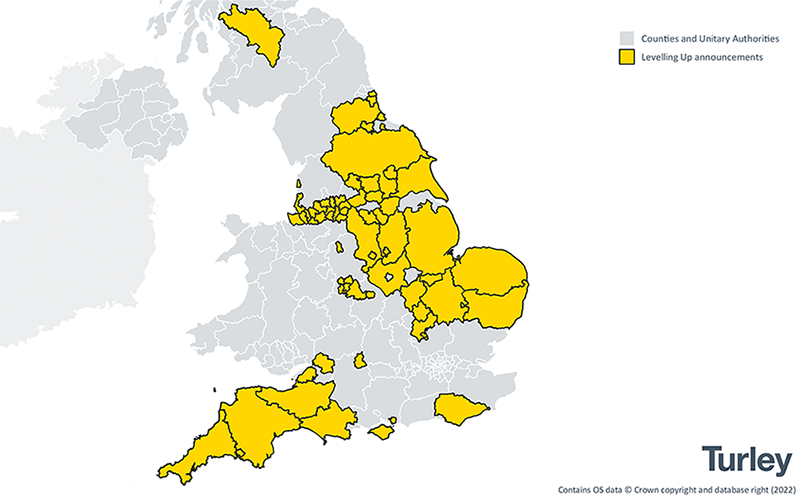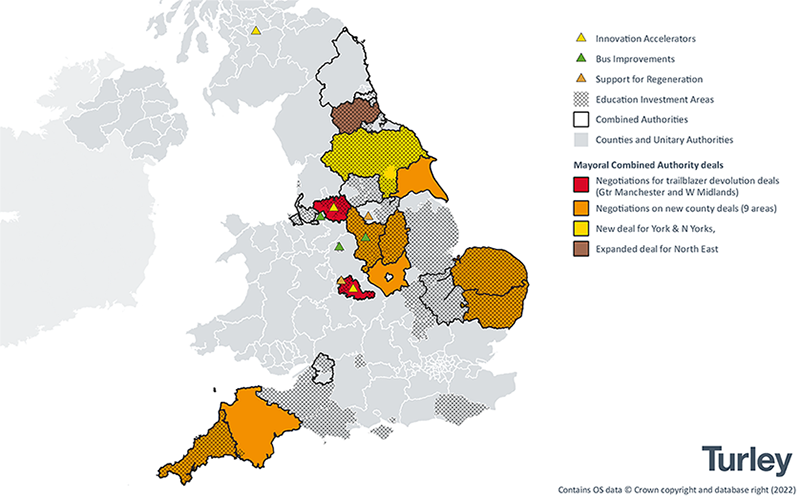Comment
Levelling Up: redrawing the map
One of the positive aspects of the Levelling Up agenda is that it has sparked a conversation about the economic, social and political geography of the UK. Important questions have been raised about the inequalities between places, why they exist and how they can be reduced.
The stakes are high not only politically but also in very real terms: peoples’ life chances and prosperity over the long term depend on how effective the White Paper is in delivering a structural change in the economic geography of the UK.
Does the White Paper live up to its’ name and actually redistribute resources and initiatives to reduce disparities between places? Is the map of the UK’s regional economic development effectively being redrawn by the Government?
In this brief article we take a look at the spatial pattern of the main investments and initiatives that have been announced so far. This does not catalogue previous funds that have been announced and allocated. For details of these historic allocations please refer to the appendices of the White Paper which contain regional level mapping of committed investment.
Mapping the Announcements
We have mapped the flagship announcements which have been made in the White Paper to show how they are distributed spatially to places across the UK. The base for our mapping is counties and combined authorities – the geographical units that the Government will be dealing with over the next decade to 2030.
We have mapped the following announcements:
- The first 9 areas invited to enter negotiations for new county deals including Cornwall, Derbyshire & Derby, Devon, Plymouth and Torbay, Durham, Hull & East Yorkshire, Leicestershire, Norfolk, Nottinghamshire & Nottingham, and Suffolk.
- A new Mayoral Combined Authority deal for York and North Yorkshire and expanded Mayoral Combined Authority deal for the North East.
- Negotiations for ‘trailblazer’ devolution deals with the West Midlands and Greater Manchester to extend their powers.
- 3 new Innovation Accelerators, major place-based centres of innovation, centred on Greater Manchester, the West Midlands, and Glasgow-City Region.
- Bus improvements in mayoral city-regions, Stoke-on-Trent, Derbyshire and Warrington
- 55 Education Investment Areas (EIAs) designated in local authorities in England where school outcomes are weakest.
- Support for the regeneration of 20 towns and cities – the first two of which have been announced in Sheffield and Wolverhampton.
At the time of writing it was not possible to map some of the other announcements which will have spatial implications including the additional “69 authorities to be supported by the High Streets Task Force” and the remaining 18 towns and cities which are to be selected for regeneration support.
Spatial analysis of Levelling Up announcements in the White Paper
Our first plan shows the overarching spatial pattern of Levelling Up announcements across the UK (the areas highlighted in yellow). This is then followed by a second plan which categorises the initiatives / status awarded to different locations as set out in the White Paper.


Our analysis shows that on paper at least the White Paper is seeking to redraw the economic geography of the UK through its spatial targeting of initiatives to places.
There are clear spatial clusters of Levelling Up initiatives in all English regions outside London and the South East. If the Government wanted this key message to land effectively then our mapping shows how pronounced the new spatial pattern of Government backed initiatives are outside London and the South East. The geographical spread of initiatives spans from Cornwall to the Glasgow City Region with a pronounced cluster of initiatives and activities in the North West and North East regions and West Midlands. Notable absences, with the exception of the Glasgow City Region, include any initiatives allocated to Northern Ireland, Wales or Scotland.
The distribution of initiatives to areas outside London and the South East on its own is apparently not sufficient to ensure that Levelling Up occurs. There are many complex and inter-related factors at play and which the White Paper sets out at length. Clearly the distribution of funding and investment are important factors and it is concerning that no new funding has been announced in the White Paper. The efficacy of the new initiatives announced today therefore remains to be seen.
Furthermore, unlike measures trail blazed by Labour and Conservative Governments over the last 40 years, the White Paper contains no fiscal measures or financial incentives to attract investment to places. Nor does it address commercial viability issues that affect so many places in desperate need of regeneration. It appears to be agnostic to the real spatial differences in the economics of development that exist between different places in the UK. Perhaps the support for regeneration of 20 towns and cities will help to address this unanswered question, but clearly there are many more than 20 places in need of regeneration.
Much of the detail is not contained in the White Paper and is deferred to negotiations with counties and Mayoral Combined Authorities at some undetermined point in the future. This is deliberately, and necessarily, a different way of doing business linked to the drive for greater devolution, but it does not build confidence in the effectiveness of the plans. The imprecise nature of the White Paper means however that its effectiveness in redrawing the economic geography of the UK may not be known for some time.
Economic geography redrawn?
The White Paper sets a “fuzzy” spatial and policy blueprint for Levelling Up for the next decade. Our initial analysis is that the distribution of measures appears to be spatially aligned with its prime objective of redistributing the focus of activities beyond London and the South East however this has not been matched yet with new or additional funding.
It is critical that future spending reviews and budgets ensure a real increase in funding and investment to those areas targeted if Levelling Up is to have a tangible and positive effect on people’s lives. Greater co-ordination between the Treasury and the Department for Levelling Up, Housing and Communities is required to liberate the investment need to rebalance and Level Up.
If the Government is really serious about redrawing the economic geography of the UK and Levelling Up it should also heed the recent advice of the National Audit Office (NAO). Ensuring the design of programmes and initiatives are informed by what works and that they are subject to rigorous evaluation are essential ingredients to success that the NAO point to.
Rather than a definitive redrawing of the map, the White Paper is better thought of as a route map and a work in progress that may take some time to complete.
Please contact Richard Laming if you wish to discuss the Levelling Up White Paper.
3 February 2022